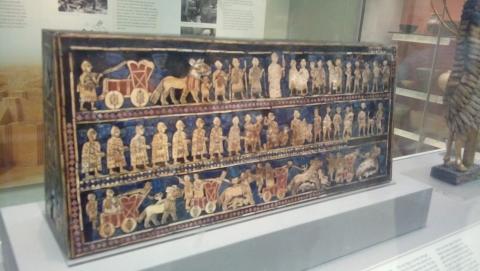Standard of Ur

The Standard of Ur is one of the British Museum’s chief treasures. The object was named at the time of excavation by Leonard Woolley because it was found near the shoulder of a man, as if it were being carried on a pole like a battle standard. It is a hollow box and its original function is not yet known. It was found in grave PG 779, a large royal grave with several tomb chambers, which had been thoroughly robbed in antiquity. The 'standard' is decorated on all four sides with mosaic scenes made with incised shell, red limestone and lapis lazuli inlay, which were originally set in bitumen on a wooden frame. It was found crushed by the weight of soil and stones and the wooden structure had completely decayed. The arrangements of the inlay pieces were ingeniously preserved by Woolley by applying wax.
The two long sides show a scene of war and a scene of peace and prosperity. They also depict two aspects of Sumerian kingship - the ruler as a warrior and as a mediator between his people and the gods. Pagan religion often combined civil rule with religious mediation, as did the Hasmonean Jews and medieval Roman pontiffs. Yet only Jesus Christ, King of kings and Priest of priests can truly be ruler and mediator. All other king-priests either anticipate His ministry, or attempt to plagiarise it. Jesus alone can mediate between you and the Father; Jesus alone will rule your life with tenderness and equity.
- Log in to post comments


 Sunday Worship 10.45am & 6.00pm
Sunday Worship 10.45am & 6.00pm